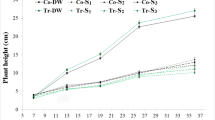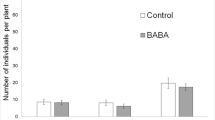Abstract
This study aimed to evaluate the effect of an agrochemical mixture, Pyraclostrobin + Metiram (Cabrio Top)® (P + M), and Bacillus subtilis on polyamine levels and their potential relationship with plant growth stages. These experiments were conducted in an area of historical disease occurrence. Thirty-two hundred tomato plants (cv. “Saladinha Plus”) were used. The trays were divided into two groups; one group received a pre-treatment of P + M (3 g l −1) and Boscalid ® (0.3 g l −1), and no products were applied to the other half of the tray. After transplanting, the following spray treatments were used: P + M (2.0 g l −1), P + M (4.0 g l −1), B. subtilis (4.0 ml l −1) and Methamidophos® (1.0 ml l −1) for 20, 35, 50 and 65 days after (DAT). To analyze the free polyamine concentrations (putrescine, spermidine and spermine), the plant material was collected at 30, 45, 60, and 75 DAT. The fruit harvest and the assessment of the total production and average fruit weight were performed at 80 DAT by selecting 20 plants from each treatment group. Higher concentrations of putrescine and spermidine were found in the plants exposed to P + M at 4.0 g l −1, indicating that polyamine concentrations may be correlated with the plant’s resistance to stress. The optimal production and weight of the tomatoes were obtained following the application of P + M, demonstrating that this agrochemical mixture has great potential to protect tomato crop yields when applied during periods of high disease incidence.




Similar content being viewed by others
References
Alcázar, R., Altabella, T., Marco, F., Bortolotti, C., Reymond, M., Koncz, C., et al. (2010). Polyamines: Molecules with regulatory functions in plant abiotic stress tolerance. Planta, 23, 1237–1249.
Bertheau, Y. D., Frechon, D., Toth, I. K., & Hyman, L. J. (1998). DNA amplification by polymerase chain reaction (PCR). In: Perombelon, M. C. M., Van Der Wolff, J. M. (Eds.), Methods for the detection and quantification of Erwinia carotovora subsp. atroseptica on potatoes. Dundee: Scottish Crop Research Institute Occasional Publication (pp. 9–16).
Bouchereau, A., Aziz, A., Larher, F., & Martin-Tanguy, J. (1999). Polyamines and environmental challenges: Recent development. Plant Science, 140, 103–125.
Cowely, T., & Walters, D. R. (2002). Polyamine metabolism in barley reacting hypersensitively to the powdery mildew fungus Blumeria graminis sp. hordei. Plant Cell Environment, 25, 461–468.
Cunha, A. R., & Martins, D. (2009). Climatic classification for the districts of Botucatu and São Manuel, SP. Irriga, 14, 1–11.
Eiras, M., Resende, R. O., Missiaggia, A. A., & Avila, A. C. (2001). RT-PCR and Dot Blot hybridization for an universal detection of tospoviruses. Fitopatologia Brasileira, 26, 170–175.
Flores, H. E., & Galston, A. W. (1982). Analysis of polyamines in higher plants by high performance liquid chromatography. Plant Physiology, 69, 701–706.
Khosroshahi, M. R. Z., Esna-Ashari, M., & Ershadi, A. (2007). Effect of exogenous putrescine on post-harvest life of strawberry (Fragaria ananassa Duch.) fruit, cultivar Selva. Scientia Horticulturae, 114, 27–32.
Kurozawa, C., & Pavan, M. A. (2005). Doenças do tomateiro. In H. Kimati, L. Amorim, A. Bergamin Filho, L. E. A. Camargo, & J. A. M. Rezende (Eds.), Manual de fitopatologia: Doenças das plantas cultivadas (4ath ed., pp. 607–626). São Paulo: Ceres.
Laitinen, J., Stenius, K., Eloranta, T. O., & Holtta, E. (1998). Polyamines may regulate S-phase progression but not the dynamic changes of chromatin during the cell cycle. Journal of Cellular Biochemistry, 68, 200–212.
Lima, G. P. P., Rocha, S. A., Takaki, M., Ramos, P. R. R., & Ono, E. O. (2008). Comparison of polyamine, phenol and flavonoid contents in plants grown under conventional and organic methods. International Journal of Food Science Technology, 43, 1838–1843.
Lourenção, A. L., Siqueira, W. J., Melo, A. M. T., Palazzo, S. R. L., Melo, P. C. T., & Colariccio, A. (2005). Resistance of tomato lines and cultivars to Tomato chlorotic spot virus E a Potato virus Y. Fitopatologia Brasileira, 30, 609–614.
Mehta, R. A., Cassol, T., Li, N., Ali, N., Handa, A. K., & Mattoo, A. K. (2002). Engineered polyamine accumulation in tomato enhances phytonutrient content, juice quality, and vine life. Nature Biotechnology, 20, 613–618.
Moschou, P. N., Sanmartin, M., Andriopoulou, A. H., Rojo, E., Sanchez-Serrano, J. J., & Roubelakis-Angelakis, K. A. (2008). Bridging the gap between plant and mammalian polyamine catabolism: A novel peroxisomal polyamine oxidase responsible for a full back-conversion pathway in Arabidopsis. Plant Physiology, 147, 1845–1857.
Nagata, T., De Ávila, A. C., Tavares, P. C. M., Barbosa, C. J., Juliatti, F. C., & Kitajima, E. W. (1995). Occurrence of different tospovirus in six States of Brazil. Fitopatologia Brasileira, 20, 90–95.
Neily, M. H., Matsukura, C., Maucourt, M., Bernillon, S., Deborde, C., Moing, A., et al. (2011). Enhanced polyamine accumulation alters carotenoid metabolism at the transcriptional level in tomato fruit over-expressing spermidine synthase. Journal Plant Physiology, 168, 242–252.
Pappu, H. R., Jones, R. A. C., & Jain, R. K. (2009). Global status of tospovirus epidemics in diverse cropping systems: Successes achieved and challenges ahead. Virus Research, 141, 219–236.
Sauve, D. M., Anderson, H. J., Ray, J. M., James, W. M., & Roberge, M. (1999). Phosphorylation-induced rearrangement of the histone H3 NH2-terminal domain during mitotic chromosome condensation. Journal of Cellular Biology, 145, 225–235.
Steel, R. G. D., & Torrie, J. H. (1980). Principles and procedures of statistics (p. 633). New York: McGraw-Hill.
Thomas, T., & Thomas, T. J. (2001). Polyamines in cell growth and cell death: molecular mechanisms and therapeutic applications. Cellular and Molecular Life Sciences, 58, 244–258.
Töfoli, J. G., Domingues, R. J., & Garcia Junior, O. (2003). Controle da requeima do tomateiro com fungicidas e seus reflexos na produção. Arquivos do Instituto Biológico, 70, 473–482.
Torrigiani, P., Bregoli, A. M., Ziosi, V., & Costa, G. (2008). Molecular and biochemical aspects underlying polyamine modulation of fruit development and ripening. Stewart Postharvest Review, 4, 1–12.
Ullman, D. E., Sherwood, J. L., & German, T. (1997). Thrips as vectors of plant pathogens. In: Lewis, T. (Ed.). Thrips as crop pests. New York: CAB International. 736 p.
Walters, D. R. (2003). Polyamines and plant diseases. Phytochemistry, 64, 97–107.
Acknowledgments
This work was financially supported by the Foundation for Research Support of the State of São Paulo (FAPESP) (2011/04339-7) and National Council for Scientific and Technological Development (CNPq) (306151/2012-0).
Author information
Authors and Affiliations
Corresponding author
Electronic supplementary material
Below is the link to the electronic supplementary material.
ESM 1
(DOC 75 kb)
Rights and permissions
About this article
Cite this article
Guimarães, L.R.P., Soler, J.M.P., Lima, G.P.P. et al. Polyamines in tomato plants grown during an incidence of tospovirus exposure. Eur J Plant Pathol 140, 701–709 (2014). https://doi.org/10.1007/s10658-014-0490-x
Accepted:
Published:
Issue Date:
DOI: https://doi.org/10.1007/s10658-014-0490-x




